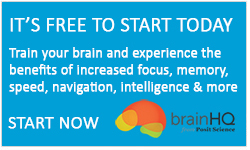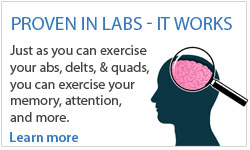Driving Cognitive Training

Welcome to our latest blog series focused on the all-important topic of driving. Just hearing the word evokes deeply-ingrained emotions with so many of them closely tied to our early life adventures of carefree cruising down the open roads. Of course as the years go by, the 2 door sports coupe we may have lusted for morphs into the more utilitarian mini-van to better deal with the daily rigours of family life and the simple need for more space.
Fast forward to our early fifties and onwards, where the kids have hopefully moved on or are at least talking about it and the freedom driving offers takes on a whole new meaning. Now it’s all about enjoying the fruits of our hard labours and indulging ourselves in the occasional week-end getaway. And thanks to the sheer numbers of aging boomers ever more Canadians are doing just that. Along the way, many stereotypes about the failings of 50 plus aged drivers are slowly fading away as well. Just the same, for some of us night time driving starts to become an issue and we tend to avoid it if at all possible. As well, we may also notice that our reflexes are just not as quick as they used to be.
So while many fifty plus aged drivers continue to drive without any noticeable cognitive or physical limitations, for increasing numbers of them, the steady march of time brings with it a gradual decline in their driving abilities.
Key challenges that boomer generation drivers face include:
 vision impairment
vision impairment diminished focus
diminished focus delayed reaction times
delayed reaction times reduced peripheral vision - useful field of view (see image below)
reduced peripheral vision - useful field of view (see image below)

Fortunately, for those boomers, who recognize that their driving skills have diminished somewhat and care to address the increased driving risks they face, there are clinically-proven steps readily available to help get them back on track.
Neuroscientists have made tremendous strides over the past few decades in recognizing and scientifically validating the plasticity of our brains. What this means is that even though we may have developed some normal age-related decline in our cognitive abilities, there are very fortunately, proven steps one can take to reverse and even improve age-related brain health changes. The incredible science of neuroplasticity not only addresses minor failings in our peripheral vision or reflex speed as an example, but can also help individuals with specific health conditions, such as brain injury, chemo brain, and cognitive impairment due to heart-failure.
The remarkable success of the original DriveSharp program, which has proven itself not just in computerized brain training modules, but more importantly in real world, everyday driving applications has earned the trust of the American Automobile Association, where some 54 million members now have access to this potentially life-saving technology. DriveSharp now forms an integral component of the BrainHQ program.
In the words of J. Peter Kissinger , President and CEO of the AAA Foundation for Traffic Safety
"The studies show these [DriveSharp] brain exercises improve reaction time, cut crash risk and increase driving confidence. Most people can benefit and can achieve their goal of continuing to drive and doing so more safely.”
Why not take our free crash risk assessment and discover what risk you may pose to fellow motorists and to the loved ones riding along in your car. It’ll only take an easy five minutes to complete, but may wind up saving you from a potentially fatal close-call down the road.
In next week’s driving blog, we’ll focus in on how brain training sharpens our driving skills.
DynamicBrain Inc. is the Canadian Partner of Posit Science Corporation providing brain fitness program, BrainHQ in English and French.






 English
English
 Français
Français


